Overview
This article delineates ten significant benefits of cooling distribution units (CDUs) for data centers, underscoring their pivotal role in enhancing energy efficiency, reliability, scalability, and sustainability. These advantages are substantiated by evidence demonstrating reduced operational costs, superior thermal management, and the capacity to adapt to the evolving demands of data centers. Consequently, CDUs emerge as a strategic investment for contemporary information facilities.
Introduction
In the rapidly evolving world of data centers, maintaining optimal cooling transcends mere technical necessity; it emerges as a strategic imperative. Organizations are currently grappling with the explosive growth of data generation alongside an urgent need for sustainability. Consequently, innovative cooling solutions have become critical components in enhancing operational efficiency while simultaneously reducing environmental impact.
Gagner-Toomey Associates is at the forefront of this revolution, providing advanced Cooling Distribution Units (CDUs) that not only optimize thermal management but also promise significant cost savings and reliability. With a diverse array of applications spanning various industries, the role of CDUs in shaping the future of data center operations is increasingly vital, paving the way for a more sustainable and efficient digital landscape.
Gagner-Toomey Associates: Innovative Cooling Solutions for Data Centers
Gagner-Toomey Associates excels in delivering innovative refrigeration solutions, such as cooling distribution units, specifically tailored for information hubs. By showcasing a diverse array of manufacturers, the company emphasizes advanced technologies that enhance temperature regulation, power management, and interconnect solutions. This commitment to innovation is crucial as the information hub refrigeration market evolves, with a marked shift towards .
Recent trends indicate that the demand for environmentally friendly refrigeration technologies is driven by the rapid increase in information generation and the global expansion of information storage. In fact, approximately 30,000 high-growth opportunities are identified annually within this sector. The information center temperature regulation market is segmented across various sectors, including:
- BFSI
- IT & Telecom
- Research & Academic
- Government & Defense
- Retail
- Energy
- Manufacturing
- Healthcare
This highlights the diverse applications of temperature control solutions. As Laura Wood, Senior Press Manager, observes, “The rising utilization of OTT and streaming services has resulted in a surge in information, encouraging market expansion.”
Furthermore, the adoption of a cooling distribution unit as part of energy-efficient temperature control systems not only reduces operational costs but also aligns with broader sustainability objectives. This is evidenced by the case study titled “Sustainability in Data Center Operations,” which illustrated that energy-efficient technologies pave the way for a more effective future.
Gagner-Toomey Associates, with its consultative approach and robust customer relationships, remains at the forefront, ensuring that information facilities can effectively manage heat loads while maintaining operational reliability and efficiency.
Energy Efficiency: Reducing Operational Costs with Cooling Distribution Units
Temperature Distribution Units play a critical role in enhancing energy efficiency within information facilities by optimizing the refrigeration process. By precisely controlling coolant circulation and maintaining optimal temperatures, chiller delivery units significantly reduce the energy required for refrigeration tasks. This increased efficiency can lead to substantial reductions in operational expenses, which often represent a significant portion of a facility’s budget.
has demonstrated that the deployment of control devices, particularly concerning chillers and refrigeration towers, can achieve a maximum relative error of only 7.32% in temperature performance, highlighting their reliability and effectiveness.
As server facilities increasingly adopt cooling distribution units, the financial benefits become apparent, establishing cooling distribution units as a strategic investment for operators aiming to enhance energy efficiency and minimize costs.
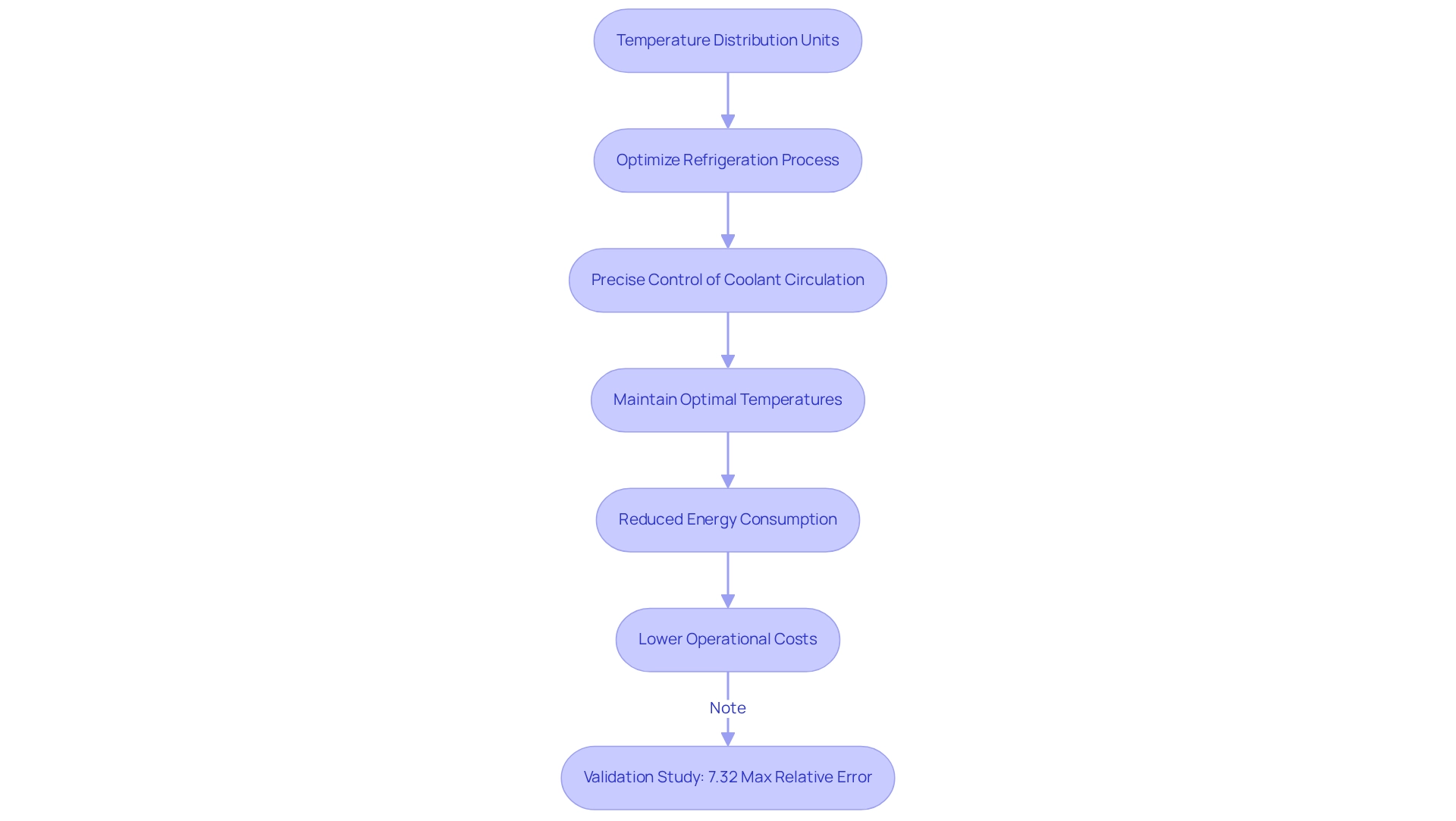
Enhanced Reliability: Ensuring Continuous Operation with CDUs
Cooling distribution units significantly enhance the dependability of server facility temperature regulation systems by ensuring a consistent and controlled flow of coolant. These units are meticulously engineered with critical redundancy features, such as backup pumps and power supplies, which guarantee uninterrupted operation even in the event of failures. This reliability is paramount in server facilities that utilize , where downtime can result in costs averaging $5,600 per minute, as highlighted by expert Eric Tomah, leading to substantial financial losses and reputational damage.
Furthermore, 43% of organizations have experienced information loss due to outages, underscoring the essential need for reliable temperature regulation solutions. By maintaining optimal temperature conditions, the cooling distribution unit effectively prevents overheating, ensuring that IT equipment operates within safe temperature ranges.
In addition, advanced analytics and automation within real-time information platforms can anticipate potential failures, enabling proactive measures that bolster the reliability of cooling systems. This integration of technology with control units exemplifies a forward-thinking approach to information management, emphasizing the critical need for redundancy and reliability in today’s information-driven landscape.
Moreover, as sustainability becomes increasingly vital in the expansion of information facilities, the role of the cooling distribution unit in facilitating efficient operations aligns with evolving priorities in the sector. A case study titled ‘Real-Time Data Platforms for Downtime Prevention’ illustrates how these platforms enable continuous monitoring of system health and predictive analytics to detect anomalies, further enhancing the reliability of temperature regulation systems.
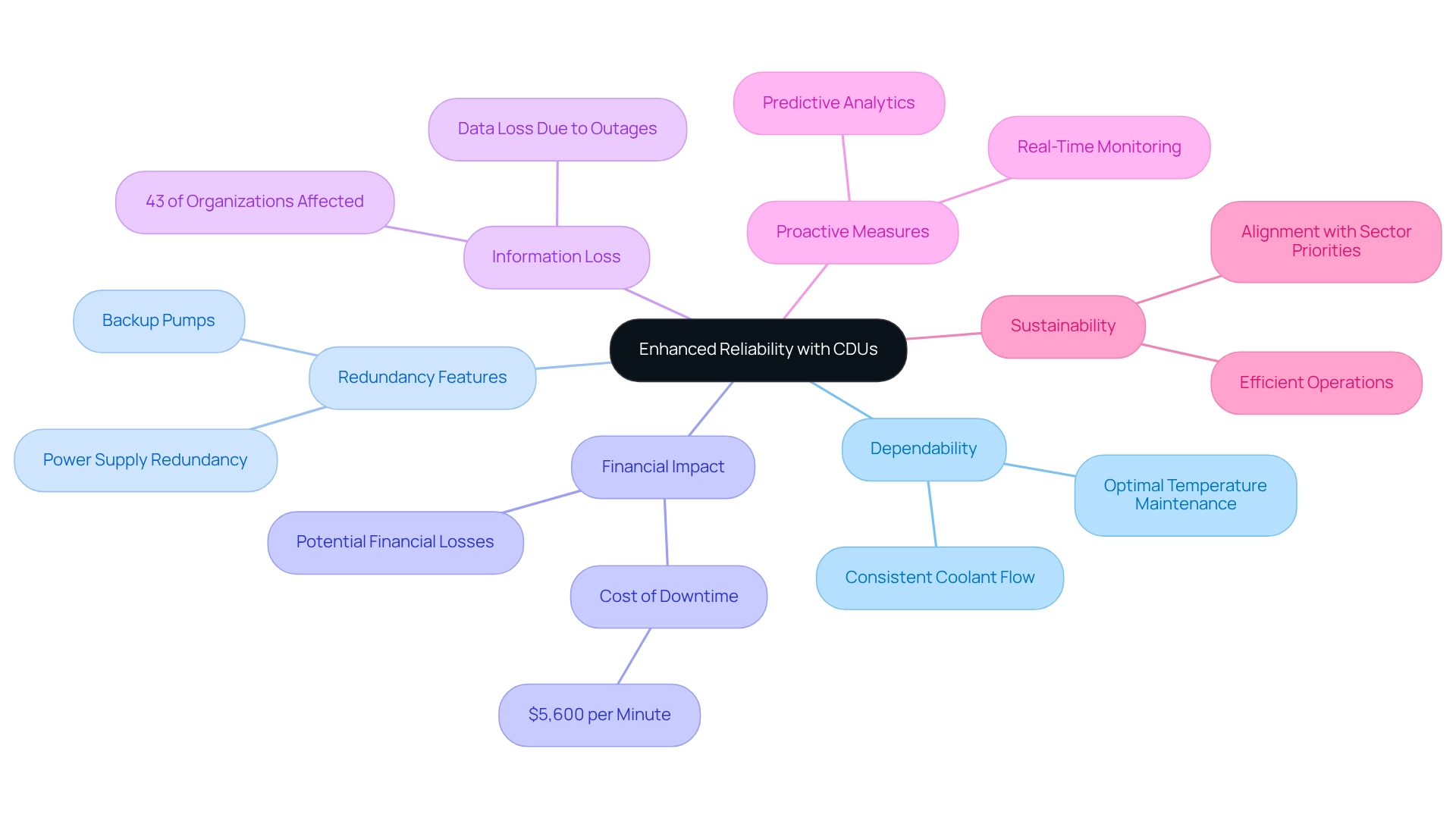
Scalability: Adapting Cooling Solutions to Growing Data Center Needs
Cooling distribution units (CDUs) provide significant scalability advantages for information facilities, allowing for seamless integration into existing systems as temperature requirements increase. This flexibility is crucial as data centers increasingly necessitate enhanced temperature control to support growing processing power and storage demands. CDUs can be tailored to manage a diverse range of temperature management loads, rendering them versatile solutions suitable for both small and large-scale operations.
Gagner-Toomey Associates, the world’s largest producer of standard and custom air-movers, provides advanced temperature control solutions optimized for performance, efficiency, and low noise. Their extensive product line includes DC input tube axial fans ranging from 15 to 280mm and centrifugal blowers from 15 to 225mm, essential for effective temperature regulation in information facilities. Recent trends indicate that row/rack-based temperature control systems, including chilled distribution units, are projected to experience the highest growth rate in the segment from 2023 to 2030. This growth is driven by ongoing investments in infrastructure development, particularly in emerging regions, which are expected to boost demand for scalable temperature control solutions. Such investments directly impact the scalability of temperature management systems, empowering facilities to improve their environmental control capabilities in alignment with expanding operational needs.
For instance, achieving N+1 redundancy at the row level necessitates the use of two cooling distribution units, illustrating how enhances operational efficiency and reliability within facilities. The market for temperature regulation in facilities is segmented across various sectors, including BFSI, IT & Telecom, Research & Academic, and Healthcare. Each sector presents distinct temperature regulation requirements, underscoring the importance of flexible temperature control solutions that can evolve alongside industry-specific demands. As Abhishek Gupta, Director of Engineering for Liquid Cooling and Networking, emphasizes, “Improved serviceability comes not only from how well a particular component fits within a system to start with, but also how friendly the design is to maintain and service.” As server facilities continue to expand, the capability of cooling distribution units, bolstered by Gagner-Toomey Associates’ innovative cooling solutions, to scale effectively will be crucial for ensuring optimal cooling performance and operational efficiency. To explore Gagner-Toomey Associates’ products or locate a distributor, please visit their website.
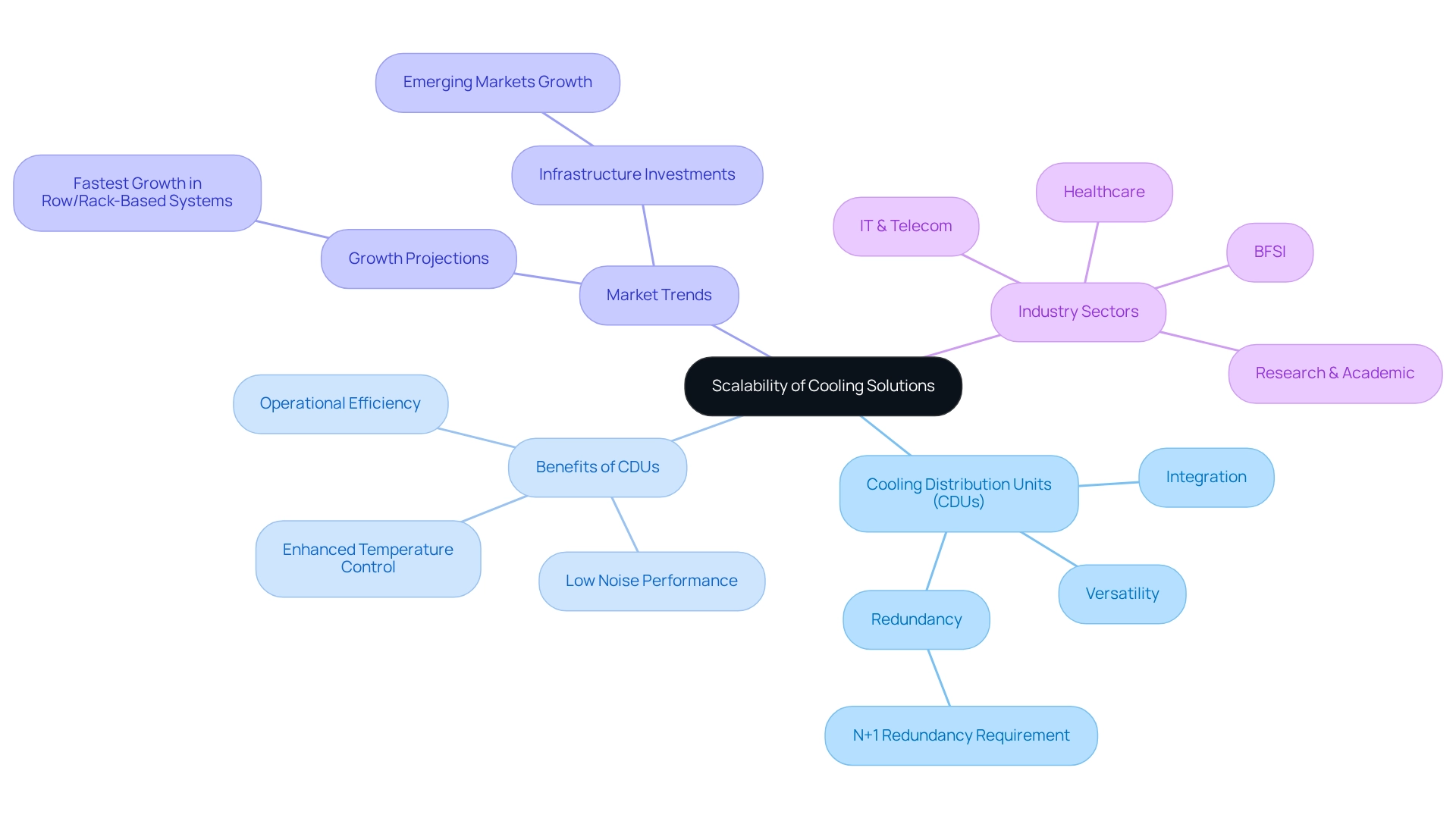
Improved Thermal Management: Optimizing Performance with CDUs
are essential for optimizing thermal management in data centers. By supplying coolant directly to heat-producing components, the cooling distribution unit maintains temperatures within ideal ranges, effectively preventing hotspots that could compromise server and networking equipment performance. This targeted temperature regulation strategy not only enhances operational efficiency but also extends the lifespan of critical IT assets, thereby minimizing the need for premature replacements.
As the information hub refrigeration market is projected to expand at a compound annual growth rate (CAGR) of 13.4%, with the Asia Pacific region expected to exhibit a CAGR of 10.9%, the significance of temperature management units in enabling high-performance computing and energy efficiency becomes increasingly evident. Enhanced thermal control through a cooling distribution unit is directly correlated with improved server performance, establishing it as an indispensable element in modern computing facility infrastructure.
Furthermore, considering that approximately 20% of global server capacity is dedicated to AI, the demand for effective temperature management solutions is more critical than ever. To fully leverage the advantages of climate control units, facility operators must regularly assess their temperature management strategies and contemplate the integration of advanced thermal management technologies.
Environmental Sustainability: Reducing Carbon Footprint with CDUs
Cooling distribution units (CDUs) are crucial for advancing environmental sustainability by significantly reducing the carbon footprint of information facilities. By optimizing energy usage and leveraging , these systems effectively diminish greenhouse gas emissions linked to cooling operations. Notably, water-cooled facilities utilizing CDUs can achieve approximately 10 percent lower carbon emissions compared to traditional air-cooled systems.
Additionally, many control units are engineered to integrate seamlessly with renewable energy sources, thereby enhancing their sustainability credentials. This alignment with corporate social responsibility initiatives not only bolsters an information facility’s environmental impact but also positions it favorably in an increasingly eco-conscious market.
Case studies illustrate that data centers employing cooling distribution units have successfully realized substantial reductions in their carbon footprints, underscoring the tangible benefits of these sophisticated temperature regulation solutions.
However, as organizations strive for carbon neutrality, it is imperative to consider the complexities involved in selecting temperature control technologies. Researchers at Microsoft highlight that key factors influencing decision-making encompass:
- Time-to-market
- Regulatory and supply chain landscapes
- Technology complexities
- Implementation costs
Furthermore, while two-phase immersion cooling offers advanced cooling techniques, it faces challenges associated with engineered fluids that possess global warming potential and health risks. Consequently, the adoption of cooling distribution units emerges as a strategic move towards a more sustainable future, as they play an essential role in achieving the goal of carbon neutrality.
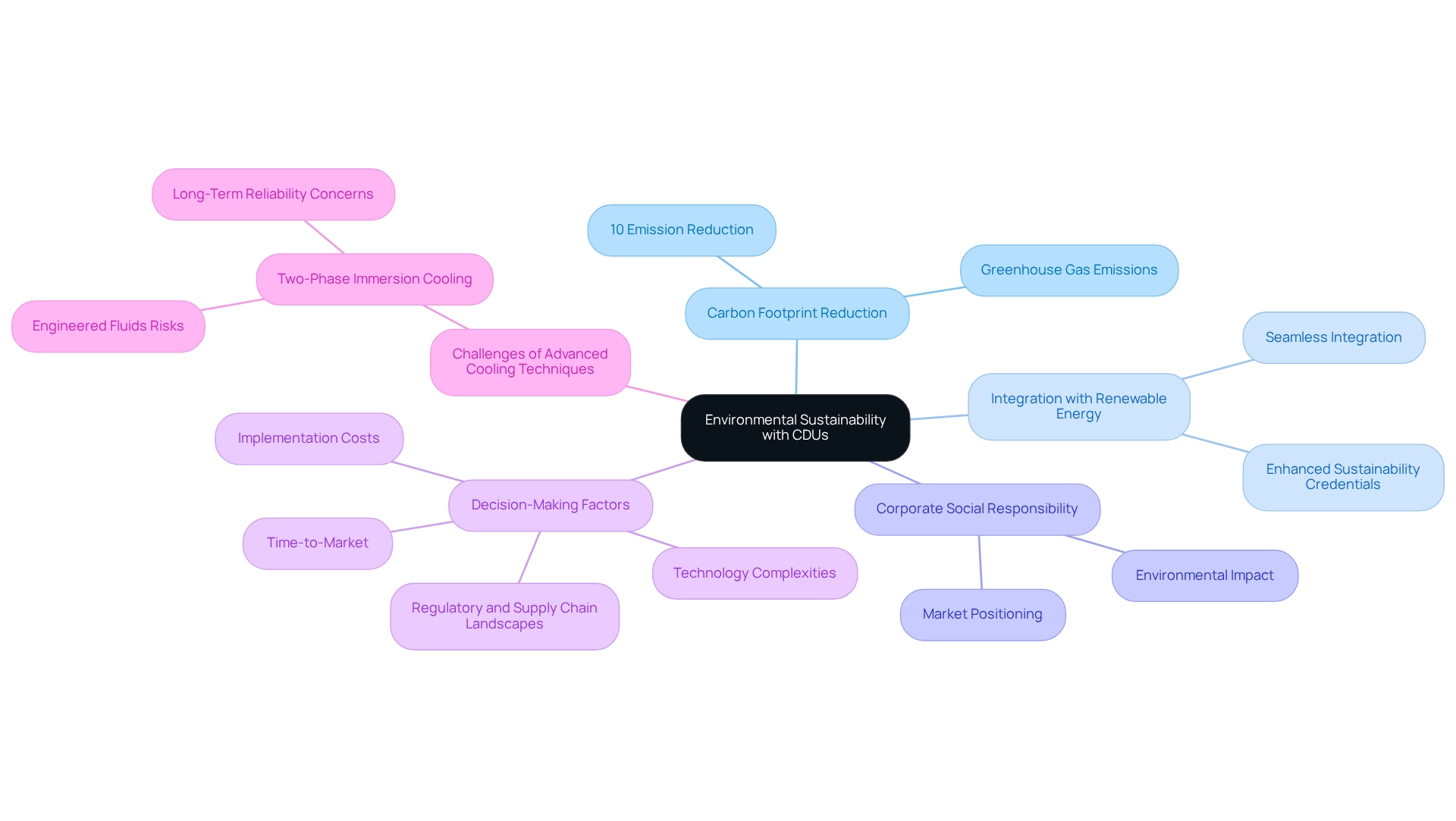
Ease of Maintenance: Simplifying Operations with Cooling Distribution Units
are meticulously engineered to enhance maintenance efficiency, featuring accessible components and streamlined operational protocols. Routine maintenance tasks, such as monitoring coolant levels and inspecting pumps, can be executed swiftly, significantly reducing downtime. Numerous control units are equipped with sophisticated monitoring systems that provide real-time performance information, facilitating proactive maintenance approaches that reduce the likelihood of unforeseen failures. This emphasis on maintenance efficiency not only improves the reliability of facility operations but also leads to significant cost reductions.
For instance, implementing a well-structured preventive maintenance program can decrease the likelihood of unplanned outages by up to 66%. As the market for information hubs is projected to undergo substantial growth from 2026 to 2033, the significance of effective temperature regulation solutions, including the cooling distribution unit, will only increase.
The nVent HOFFMAN RackChiller is a cooling distribution unit CDU800 that exemplifies this approach, designed to meet the high-density liquid cooling requirements of contemporary facilities while streamlining operational procedures. By reducing the need for unnecessary units, the CDU layout enables simpler planning and faster setup, ultimately enhancing facility management and boosting overall performance. Moreover, the design of the cooling distribution unit RackChiller CDU800 specifically addresses maintenance efficiency, ensuring that information hubs can operate seamlessly in an increasingly interconnected world.
Integration Capabilities: Seamlessly Incorporating CDUs into Data Center Infrastructure
Cooling distribution units are engineered for seamless integration into existing information hub infrastructures, enabling operators to connect them with various temperature regulation systems, including chilled water circuits and direct-to-chip temperature management arrangements. This adaptability empowers data center managers to deploy distribution units without necessitating a comprehensive overhaul of their temperature regulation framework.
Notably, in 2023, over 65% of new cooling distribution unit deployments incorporated adaptive flow control, underscoring the shift towards . Moreover, control devices can be tailored to meet specific operational needs, ensuring optimal performance across diverse environments.
Gagner-Toomey Associates, recognized as the world’s largest manufacturer of standard and custom air-movers, provides an extensive product line of DC input tube axial fans and centrifugal blowers, ranging from 15mm to 280mm and 15mm to 225mm, respectively. These fans are optimized for performance, efficiency, and low noise, significantly enhancing the effectiveness of cooling devices in electronics and automotive applications.
This level of customization and integration capability positions the cooling distribution unit as an indispensable component in modern information facility temperature regulation strategies, ensuring it can adapt to the evolving demands of IT applications.
Cost-Effectiveness: Long-Term Savings with Cooling Distribution Units
Investing in a cooling distribution unit offers substantial long-term savings for data centers. While the initial costs may surpass those of traditional cooling systems, the achieved through enhanced energy management and reduced maintenance expenses can swiftly recover these upfront investments.
Cooling devices are engineered to manage high heat loads effectively, thereby boosting energy efficiency and extending the lifespan of critical equipment. This ultimately results in a significantly lower total cost of ownership (TCO) over time.
For instance, facilities that employ cooling distribution units have reported energy usage reductions of up to 30%, along with decreased operational costs, resulting in a favorable return on investment.
As Tod Higinbotham, COO at ZincFive, asserts, “data centers should embrace immediate power solutions (IPS) as a way to enhance operational efficiency.”
Furthermore, the implementation of cooling distribution units fosters environmental sustainability by lowering carbon dioxide emissions, making these units a prudent choice for both economic and ecological reasons.
The case study titled ‘Cooling Distribution Units in Data Centers’ underscores how these cooling distribution units enhance efficiency and reliability, thereby reinforcing claims of reduced power usage and promoting environmental sustainability.
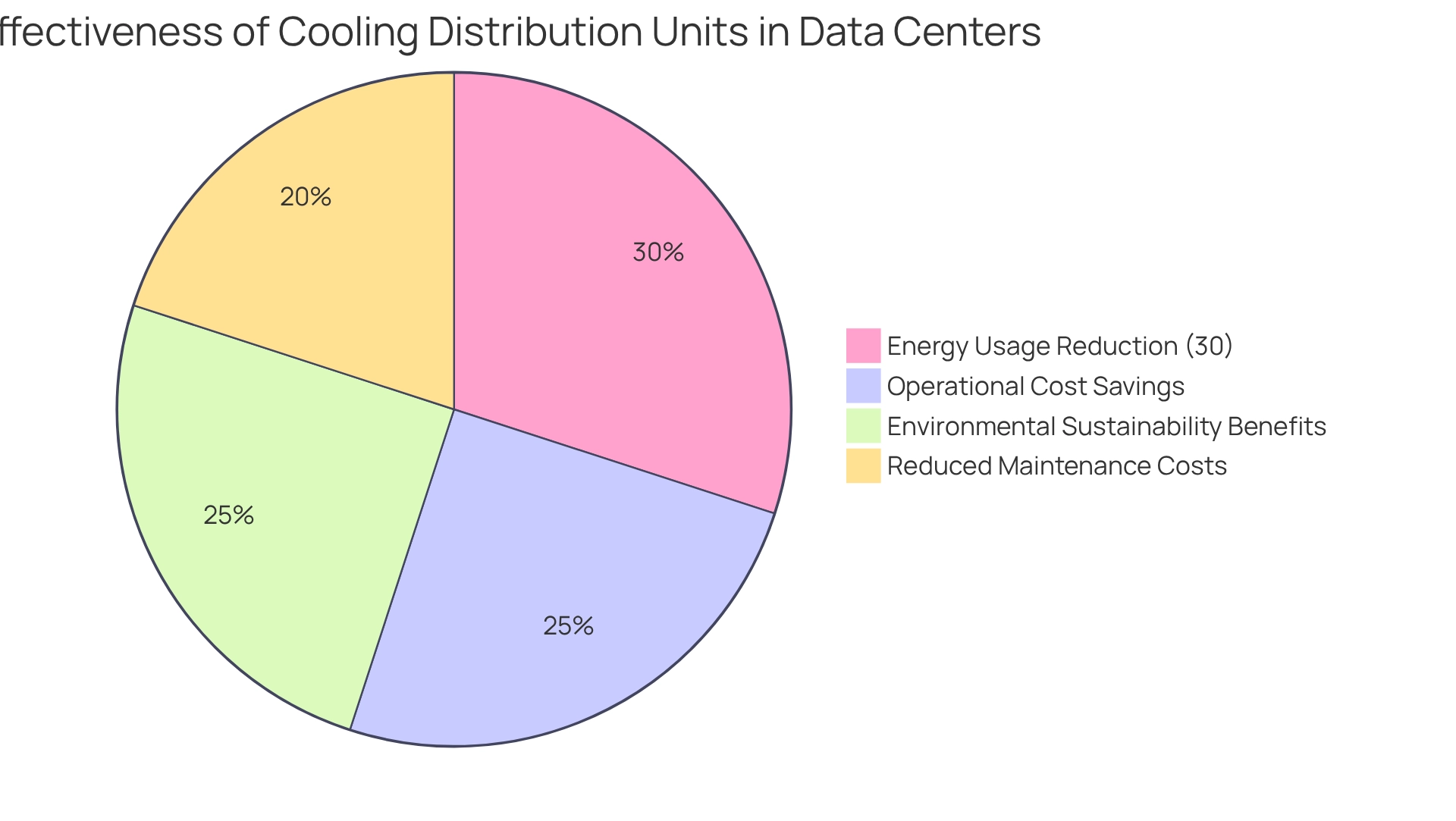
Technological Advancements: The Future of Cooling Distribution Units in Data Centers
The future of cooling distribution units is exceptionally promising, driven by continuous technological advancements that enhance both performance and efficiency. Innovations, particularly AI-driven monitoring systems, are revolutionizing the cooling distribution unit operations, facilitating real-time adjustments that optimize temperature regulation according to current demands. Moreover, the adoption of advanced materials for heat transfer is significantly improving thermal management, resulting in more efficient temperature regulation solutions. A notable example is Daikin Applied’s Navigator WW water-cooled screw chiller, which utilizes low-global warming potential refrigerant, underscoring a commitment to sustainability in temperature control technologies.
The integration of renewable energy sources is increasingly vital, aligning CDU operations with broader sustainability objectives. As information hubs face the growing challenge of heightened high-density computing requirements, the cooling distribution unit will play a critical role in delivering effective temperature regulation while advancing overall operational sustainability. The anticipated expansion of row and rack-based temperature control systems is expected to have a substantial impact on , highlighting the need for effective strategies to balance loads on temperature regulation equipment. Effective management, as emphasized in recent reports, is crucial to ensuring that temperature regulation systems operate efficiently under varying loads.
In this competitive landscape, where price sensitivity may hinder investment in research and development, innovative refrigeration technologies will be pivotal for sustaining technological advancement and market growth. For instance, Vertiv’s collaboration with Intel to launch a liquid cooling solution compatible with the groundbreaking Intel Gaudi3 AI accelerator exemplifies how strategic partnerships can foster innovation in this sector. Furthermore, a comprehensive understanding of market competition dynamics, as detailed in the case study titled ‘Market Competition and Price Sensitivity in the cooling distribution unit sector,’ is essential for navigating the challenges and opportunities present within the cooling distribution unit market.
Conclusion
The importance of Cooling Distribution Units (CDUs) in contemporary data centers is paramount. As organizations confront the dual challenges of increasing data generation and the urgent need for sustainability, CDUs emerge as indispensable tools that enhance energy efficiency, bolster reliability, and facilitate scalability in cooling operations. Their capability to optimize thermal management not only elevates operational performance but also prolongs the lifespan of critical IT assets, effectively reducing unnecessary costs.
Furthermore, the integration of CDUs into existing infrastructures grants data centers the flexibility required to meet escalating demands without necessitating a complete overhaul of their cooling systems. The long-term cost savings associated with CDUs, combined with their environmental advantages, position them as a strategic investment for the future. With technological advancements ushering in smarter cooling solutions, the significance of CDUs will only intensify in the pursuit of operational excellence and sustainability objectives.
As the data center landscape continues to transform, adopting innovative cooling solutions like CDUs is vital for organizations striving to excel in a competitive and environmentally aware market. By prioritizing efficient cooling strategies, data centers can not only enhance their operational capabilities but also play a pivotal role in fostering a more sustainable digital future.
Frequently Asked Questions
What innovative solutions does Gagner-Toomey Associates provide?
Gagner-Toomey Associates specializes in delivering innovative refrigeration solutions, including cooling distribution units specifically designed for information hubs, emphasizing advanced technologies for temperature regulation, power management, and interconnect solutions.
What trends are driving the demand for environmentally friendly refrigeration technologies?
The demand for environmentally friendly refrigeration technologies is driven by the rapid increase in information generation and the global expansion of information storage, with approximately 30,000 high-growth opportunities identified annually in this sector.
Which sectors are involved in the information center temperature regulation market?
The information center temperature regulation market includes sectors such as BFSI (Banking, Financial Services, and Insurance), IT & Telecom, Research & Academic, Government & Defense, Retail, Energy, Manufacturing, and Healthcare.
How do cooling distribution units contribute to energy efficiency?
Cooling distribution units enhance energy efficiency by optimizing the refrigeration process, precisely controlling coolant circulation, and maintaining optimal temperatures, which significantly reduces the energy required for refrigeration tasks and operational expenses.
What reliability features do cooling distribution units offer?
Cooling distribution units are engineered with critical redundancy features, such as backup pumps and power supplies, ensuring uninterrupted operation even during failures, which is crucial for preventing downtime in server facilities.
What financial impact can server facility downtime have?
Downtime in server facilities can result in costs averaging $5,600 per minute, leading to substantial financial losses and reputational damage, highlighting the importance of reliable temperature regulation solutions.
How does advanced analytics enhance the reliability of cooling systems?
Advanced analytics and automation within real-time information platforms can anticipate potential failures, enabling proactive measures to bolster the reliability of cooling systems, ensuring optimal temperature conditions and preventing overheating.
How does the role of cooling distribution units align with sustainability objectives?
The role of cooling distribution units in facilitating efficient operations aligns with evolving sustainability priorities in the expansion of information facilities, contributing to energy-efficient temperature control systems and reduced operational costs.

